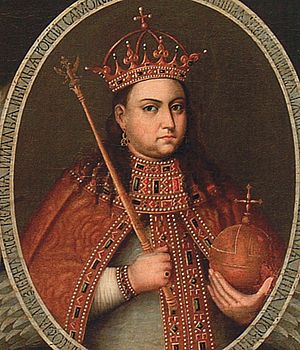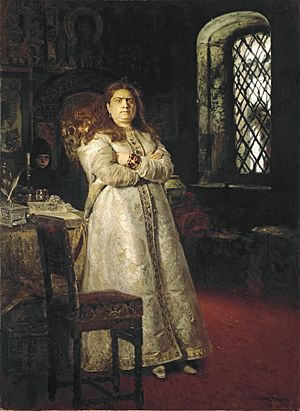Sophia Alekseyevna of Russia facts for kids
Quick facts for kids Sophia Alekseyevna |
|||||
|---|---|---|---|---|---|

1680s portrait
|
|||||
| Regent of Russia | |||||
| Regency | 8 June 1682 – 22 September 1689 | ||||
| Monarchs | Peter I and Ivan V | ||||
| Born | 27 September 1657 Moscow, Russia |
||||
| Died | 14 July 1704 (aged 46) Novodevichy Convent, Russia |
||||
| Burial | Archangel Cathedral | ||||
|
|||||
| House | Romanov | ||||
| Father | Alexis I | ||||
| Mother | Maria Miloslavskaya | ||||
| Religion | Eastern Orthodox | ||||
Sophia Alekseyevna (Russian: Со́фья Алексе́евна; born September 27, 1657 – died July 14, 1704) was a powerful Russian princess. She ruled Russia as a regent from 1682 to 1689. A regent is someone who governs a country when the true ruler is too young or unable to rule.
Sophia took charge when her younger half-brother, Peter I, and her older brother, Ivan V, were too young to rule. She was known for being a strong leader. It was very unusual for a woman from a noble family in Moscow to be involved in politics. Women were usually kept away from public life.
Contents
Early Life of Sophia Alekseyevna
Sophia was the third daughter of Tsar Alexis and his first wife, Maria Miloslavskaya. She was special because she was the only one of her sisters who received a good education. Her teacher was Simeon Polotsky, who also taught her brothers, Alexei and Feodor.
After her brother Tsar Feodor III died in 1682, Sophia stepped into politics. She wanted to stop her nine-year-old half-brother, Peter, from becoming tsar. She believed her 16-year-old brother, Ivan, should be next in line.
How Sophia Became Regent
Sophia became very important during the power struggles of 1682. Even before this, she had some influence. When the ruler changed in 1676, Sophia might have tried to help her brother Feodor. Some stories say she asked her dying father, Tsar Alexis, not to name Peter as his heir.
Feodor was not very strong or healthy, so some people doubted if he could lead Russia. However, he became quite smart thanks to his teacher, Simeon Polotsky. During Feodor III's short reign (1676-1682), many historians believe Sophia secretly helped him rule.
As Tsar Feodor's health got worse, Sophia's influence began to fade. Since women were usually kept out of politics, she used her connections to make allies. She planned to secure power for herself. When Feodor died in 1682, Sophia quickly returned to the political scene. She even went to her brother's funeral, which was very unusual for women at that time. Her presence caused a stir and started the events that led to her becoming regent.
Sophia's family, the Miloslavskys, used a soldier uprising in Moscow in 1682 to gain power. Tsar Alexis had two families, and both had male heirs. Sophia created a plan to get power for herself and her family. She argued that her brother Ivan was the rightful heir. She tried to convince the church leader (patriarch) and the nobles to change their decision to crown Peter.
Sophia said that crowning Peter broke the rules because it skipped over Ivan. She suggested that Ivan and she should rule together. When this idea was quickly rejected, Sophia turned to the unhappy soldiers, called the streltsy. These soldiers were already upset about many things, including harsh treatment. They were angry about Peter being chosen over Ivan. After much fighting, the streltsy got their way.
After the streltsy rebellion, on June 25, 1682, the Patriarch Ioakim crowned Ivan as the senior tsar (Ivan V). Peter, who was only nine, was crowned as the junior tsar. Sophia was seen as the only adult in the ruling family who was smart enough to govern. She used her political skills, learned from Feodor, to convince the nobles and the patriarch that she could rule Russia. As Sophia had planned, Vasily Golitsyn became the main head of the government. He carried out most of the policies during her time as regent.
Sophia's Time as Regent

In late 1682, a group called the Old Believers joined the rebels. They wanted to undo some church reforms. Sophia lost control of the streltsy to her former ally, Prince Ivan Khovansky. Khovansky used his influence with the soldiers to make Sophia's court leave the Moscow Kremlin. They had to find safety in the Troitse-Sergiyeva Lavra monastery.
The streltsy rebels hoped to remove Sophia and make Khovansky the new regent. Sophia gathered her own army and stopped this rebellion, known as the Khovanshchina. She got help from Fyodor Shaklovityi, who took charge of the Moscow army. Sophia had Khovansky and other rebel leaders executed. She kept the unhappy groups quiet until Peter was old enough to rule.
During her seven years as regent, Sophia made some changes. She gave some benefits to townspeople and made rules about runaway peasants less strict. This made some nobles unhappy. She also worked to improve the military. Sophia was interested in a fancy building style called baroque. She helped develop a foreign district in Moscow and created the Slavonic-Greek-Latin Academy. This was Russia's first higher learning institution.
Her foreign policy was very important, led by Golitsyn. Key achievements included:
- The Eternal Peace Treaty of 1686 with Poland.
- The 1689 Treaty of Nerchinsk with China.
- The Crimean campaigns against Turkey.
Sophia's rule saw important diplomatic agreements and growth within Russia. Her influence on a young Peter was also very significant. The rebellion of 1682 made Peter distrust nobles, which shaped his future leadership.
Sophia's Downfall
As Peter I grew older, he started to take on more power. When he was 16, Peter demanded that Golitsyn report to him about everything. Peter's family, the Naryshkin family, was getting ready to take control. In 1688, Peter began to promote people from his own family, and Sophia could not stop this shift in power.
During this time, Sophia seemed to ignore the young tsar. She let him train his special guards, the Preobrazhensky and Semenovsky Guards, in Preobrazhenskoe. Some historians think Sophia tried to keep Peter away from politics, but it's not fully clear.
Sophia and her supporters had talked about making her tsarina. In 1687, they tried to get the streltsy to support her. But the streltsy refused to help. By 1688, Sophia and her group were losing power. A war in Crimea caused riots and unrest in Moscow. To make things worse for Sophia, Peter got married, showing he was ready to rule. Also, Ivan V had a daughter, which meant his family branch would not have a male heir to the throne.
Tensions between the two sides grew. When Peter I turned 17, his Naryshkin relatives demanded that Sophia step down. In response, Shaklovityi told Sophia to declare herself tsarina. He tried to get the streltsy to start another uprising. However, most of the streltsy left central Moscow and went to Peter, who was living in the Troitse-Sergiyeva Lavra.
Feeling her power slipping away, Sophia sent nobles and the patriarch to Peter. She asked him to join her in the Kremlin. Peter refused. He demanded that Shaklovityi be executed and Golitsyn be sent away.
Sophia agreed to give up her main supporters. She was arrested and forced to go to the Novodevichy Convent. She did not officially become a nun at first. Sophia might have made one last attempt to get power, but her involvement is unclear. Her fate was sealed ten years later. The streltsy tried to bring her back to power while Peter was out of the country. This uprising was crushed harshly. The bodies of the rebels were hung in front of Sophia's windows. She then officially became a nun and was kept in strict isolation. Other nuns were only allowed to see her on Easter Sunday. She died in the Novodevichy Convent six years later.
See also
 In Spanish: Sofía Alekséyevna Románova para niños
In Spanish: Sofía Alekséyevna Románova para niños

